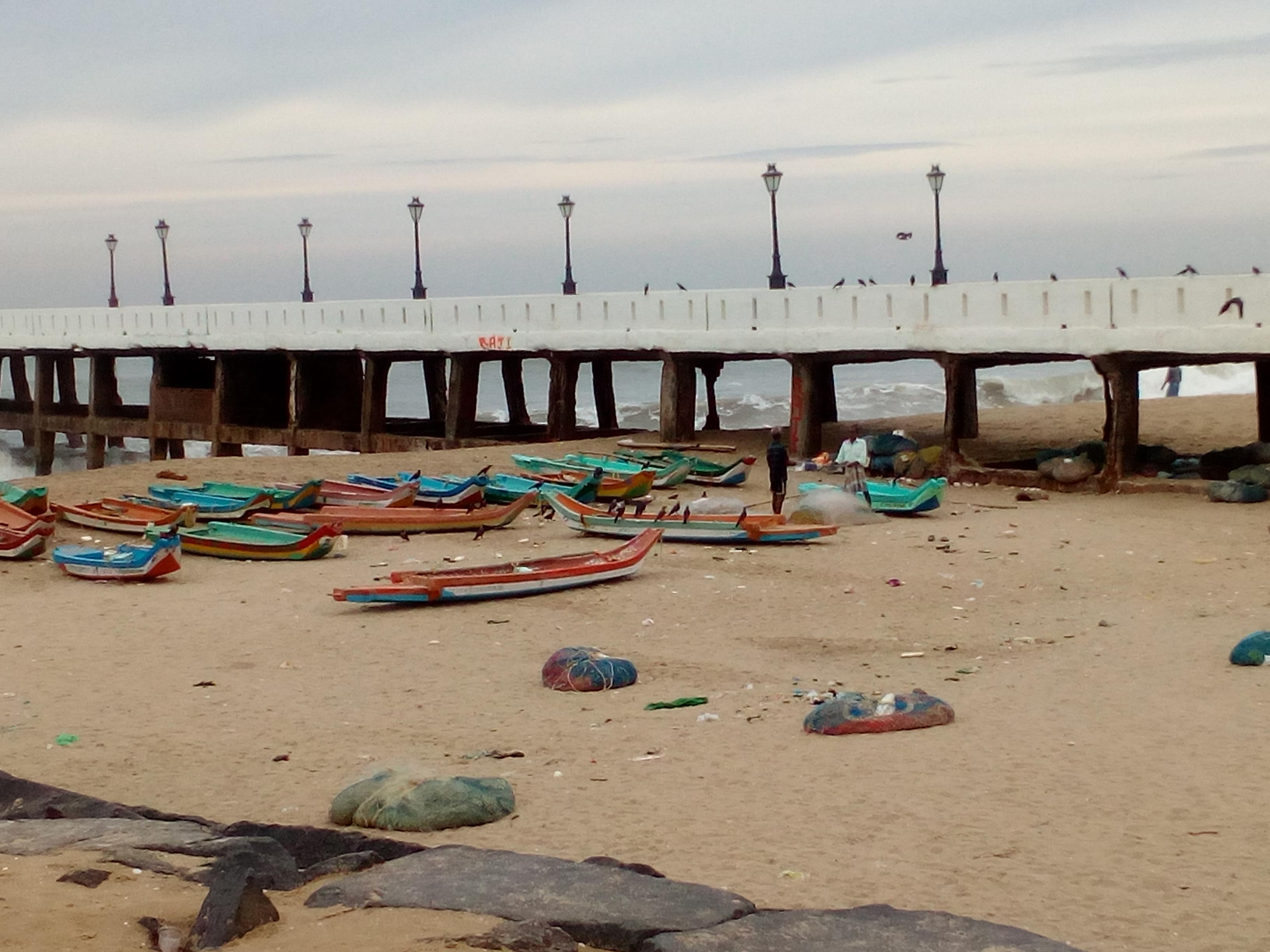
18 Sep Small-scale fishers in the lurch? – a tale from India
Tucked in between two groins on the southern side of Pondicherry, South India, is a narrow beach with a collection of small fishing craft. Every morning, as thousands of middle class residents jog up and down the magnificent boulevard, taking care of their health, fishers from an adjacent small-scale fishing neighbourhood congregate here to process their measly catches and repair their nets. They are, in the words of D. Parthasarathy (2011), the hunters and gatherers of the coastal metropolis. They are also losers in India’s rapidly evolving maritime economy, which pays lip-service to the small-scale sector but otherwise leaves them largely in the lurch.
Recognizing that the majority of the one million sea-going fishers of India belong to the small-scale sector (Articles 1, 15 and 25), the new National Policy on Marine Fisheries (2017) commits to implementing the Voluntary Guidelines on Sustainable Small-Scale Fisheries (Article 54.0). It notes, however, that “the fisheries resources from the near-shore waters are fully utilized”, and points to deep-sea waters, where expansion of fishing effort is expected to be possible. Whether sufficient resources are still available in Indian deep-sea waters, and whether this is going to help small-scale fishers is a moot question.
The Blue Revolution that was launched after India’s Independence in 1947 introduced a new, harbour-based trawl fishery that feeds on the same fishing grounds and resources as the sizeable small-scale fishing sector does. Ignoring the existence of customary law that has defined fishing rights and obligations over the centuries, the post-colonial government bulldozed the small-scale sector into submission, dangling before its nose the promise of development. What it has delivered is severe inequality and marginalization. The trawl sector, which employs a minority of fishers, now lands the highest volumes and values of sea produce, while the small-scale sector, which has been struggling to keep up, for example through the motorization of craft, has seen its catches dwindling. This is a result of the decline of the inshore marine ecology through trawling, pollution and the damming of rivers. The industrialization of the coast is also creating new impediments to fishing – new jetties, ports, and pipelines that interfere with fishing operations and create enormous beach erosion (Lakshmi et al. 2012).
Yes, there are laws in place. The Indian government has, for example, decreed that inshore waters are reserved for small-scale fishing, and that trawl vessels must proceed beyond 5 nautical miles from the shore. But implementation is virtually absent, and it is muscle- and money-power that determines the use of ocean resources. And, yes, there is a Pollution Control Board, but it is known for its lack of backbone. And while the National Policy on Marine Fisheries emphasizes the need for conservation of marine resources, government’s record is hitherto poor indeed.
So where does this leave the small-scale sector and its commendable traditions of resource conservation? Many small-scale fishers are desperately trying to paddle along, investing in outboard engines and in new gears, such as mini-purse seines, that seem to hold promise of returns. Many of them are also investing heavily in the education of their children, hoping that they will find their way into other economic sectors than what they often see as a ‘doomed’ fishery. But, as emerged from research result presented at a workshop at the French Institute of Pondicherry on August 26th, 2017, many of these children, failing in their endeavours to find other employment, return in the end to the conundrum of the fishery.
While customary fisheries management, undertaken by village level organizations called ur panchayat continues, it obviously has been losing force. What can one do against the power of industrial fisheries, that has the blessing of government? At the local level, ur panchayats still have substantial influence, and play an important role in safeguarding the wellbeing of small-scale fishing populations (Bavinck 2017). But in the larger scheme of things, and on their own, their authority is negligible.
It is here that alliances with NGOs and other social movements are helping out. The efforts of the National Coastal Protection Campaign (NCPC), the National Fishworkers Forum (NFF), and the International Collective of in Support of Fishworkers (ICSF), all of which possess voice up to level of national government, are publicly raising objections to the usual, biased course of affairs. The Voluntary Guidelines on Sustainable Small-Scale Fisheries, adopted by FAO in 2014, provide useful leveraging material for what, in the end, is a long-ddrawn social and political struggle.
The small-scale fishers tucked out of sight along Pondicherry’s avenue are amongst the worst off in India’s marine sector. With only the most simple of craft and gear, and facing the competition of many other small- and large-scale fishers at sea, they lead a basic, hand-to-mouth existence. But they are hanging on, somehow. India’s small-scale fishers are a tough bunch. They are not easily erased.
Author: Maarten Bavinck
References:
Bavinck, M. (2017). Enhancing the wellbeing of Tamil fishing communities: the role of self-governing ur panchayats along the Coromandel Coast, India, In: Johnson, D., T. Acott, N. Stacey and J. Urquhart (eds.), Social wellbeing and the values of small-scale fishing, Dordrecht: Springer.
Lakshmi, A., A. Schiavina, P. Banerjee, A. Reddy, S. Mandeen, S. Rodriguez and D. Apte (2012). The challenged coast of India. A report prepared by PondyCAN in collaboration with BNHS and TISS.
Parthasarathy, D. (2011). Hunters, Gatherers and Foragers in a Metropolis: Commonising the Private and Public in Mumbai, Economic and Political Weekly 46 (50):54-63.


